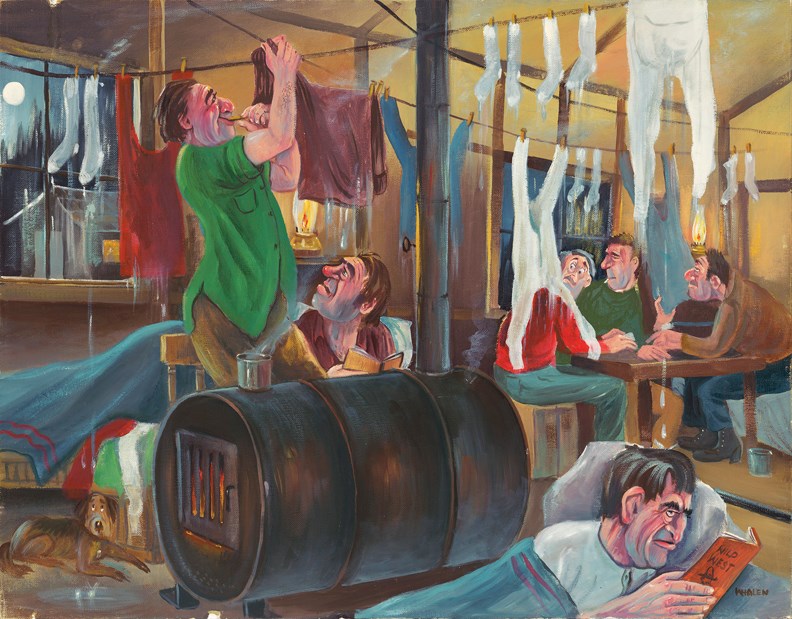Life in the remote logging camps of the last century was rough and raunchy. Long johns drying over the bunkhouse stove, rainy visits to the outhouse at night, rum, poker and women during wild visits to Vancouver. The self-taught artist Len Whalen (1910-1989) captured the lives of these men who work in the woods – the likeable and the unsavoury – in his cartoons and especially in his paintings that show some of his best work.
Whelan contributed his cartoons to the Vancouver Sun in the 1960s under the series heading of Rangitangs, a term he is credited with inventing to describe the rangy behaviour of bushed men. It is still used as a term for rigging men or loggers in general.
His son Mike Whelan who lives in Gibsons is proud of his dad’s heritage. He has published a book of his father’s comical drawings, The Cartoons of Len Whalen from 1930 to 1989, and he also sells prints of the logging camp paintings.
“He didn’t want me to sell the [painting] originals,” he said. “I could make prints and T-shirts or whatever, but I was to keep the originals in the family.”
Len Whalen went to work in the woods when he was just 18 and logged for five years. His parents were the owners of Whalen Pulp & Paper mills in Port Alice, Swanson Bay and at Woodfibre on Howe Sound. When they lost one of their biggest customers, the family was forced to sell, but Len’s father still ran a camp on Nootka Sound. Some of his first cartoons were done during the war – jokes that were stress busters for soldiers during that hard time.
After the war Len moved to Ontario and published many cartoons in Macleans magazine under the artist’s name of Leni. He hoped to become an illustrator and he composed ads for billboards and magazines. After a move to the company town of Ocean Falls in 1953, Len became part of a safety committee for Crown Zellerbach, and he drew posters and cartoons with comical safety messages that helped the mill become a number one accident-free workplace. But his logging caricatures are what brought him notoriety.
From 1949 to 1989 he published cartoons in HiBaller, a forestry magazine. “Virtually every logger had a copy in his back pocket,” Mike said. Some of the themes for the jokes: fat wives insulted by their roving and boozing husbands, are not funny today.
“That was life back then,” Mike explained. “You can’t change it. You can only look at how far we’ve come since then.”
This year Mike attended a Truck Loggers convention in Victoria and displayed some of his dad’s work to many comments from the public. The show was a hit. “They recognized the people in the paintings; they knew someone just like them.”
He hopes to develop a gallery in Gibsons devoted to the forest industry to display the 26 paintings along with wood products and crafts from local artists. Meanwhile the prints are available for purchase at www.rangitangs.com and the cartoon book is for sale at Talewind in Sechelt, the Egmont Heritage Museum and Gibsons Museum and Archives.



